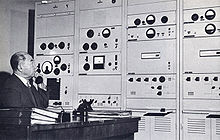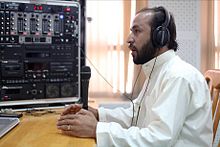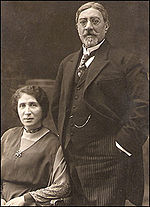- Media of Afghanistan
-
The media of Afghanistan is in the development stage, which includes printing, broadcasting and digital. It is mainly in Pashto and Dari (Persian) languages. Although it was tightly controlled under the Taliban government from 1996 to late 2001, the state media gradually relaxed press restriction and private media began growing rapidly. In 2008, Reporters Without Borders listed the media environment of Afghanistan as 156 out of 173, with 1st being most free.[1] Journalists in the country operate in one of the world's most complex and contested information environments. At times, the lines between propaganda, intelligence and journalism blur, and some journalists covering Taliban activities have been accused of treachery or arrested, while others have been kidnapped, beaten or harassed by Taliban insurgents.[2] [3] [4]
Contents
Media History
Early History
The first newspaper, Siraj-ul-Akhbar (Lamp of the News) in was initially published on January 11, 1906, with Abd al-Rauf as editor. After this first and only issue in Dari (Persian), its publication stopped. It was revived in October 1911 by Mahmud Tarzi, the editor and owner of the newspaper, who was critical of the friendship between the United Kingdom and Afghanistan. Mahmud Tarzi became known as the pioneer of Afghan journalism. In 1919, under King Amanullah Khan, Aman-i-Afghan (Afghan Peace) replaced Siraj al-Akhbar, serving as an organ of the government, while several smaller private journals appeared under different ministries.[5] Along with these developments, Radio Kabul began broadcasting in 1925, which inaugurated a new era of mass media in the country.[5] The 1964 Constitution of Afghanistan and the Press Law of 1965 provided for freedom of the press, within the boundaries of appropriate behaviour. The press was editorially independent from government but was instructed to safeguard the interests of the state and constitutional monarchy, Islam, and public order. Afghan journalism progressed and developed from the 1950s through to the 1970s, though it remained limited.
When King Zahir Shah's government was overthrown in the 1973 coup his cousin Daoud Khan, approximately 19 newspapers were shut down and media came under severe restriction, ending a period of relative freedom.[6] The first colour television broadcasting appeared in 1978.[6] The media fell into the control of Soviet influences during the People's Democratic Party of Afghanistan (PDPA) from 1979 to 1992.[7]
Taliban Era
Media under the Taliban was characterised by strict media laws, including the banning of television, seen as "morally corrupt" and music, banned under Sharia law.[6] The Taliban instigated the destruction of television sets in 1998.[8] People caught with a television were subject to imprisonment or flogging. Most media operated from other countries, except for the Taliban free areas in Northern Afghanistan, which had its own television service, Badakhshan Television, broadcasting news and films for around 5,000 viewers for three hours a day.[9][10] Television was shut down in 1996,[6] and print media were forbidden to publish commentary, photos or readers letters. The only radio station broadcast religious programmes and propaganda, and aired no music. Around 70% of the population listened to its broadcasts.[8] In 2000, the government launched The Islamic Emirate, an English-language newspaper designed to counteract information produced by the "enemies of Islam".[8] Only Russia, Czech Republic and Serbia had news bureaus based in Kabul due to instability.[6] The Kabul TV centre was converted into a military barracks, and journalists were not permitted to work with foreign media.[8] The media environment remained bleak until the overthrow of the Taliban in late 2001.
Karzai Administration
The media has experienced explosive growth in post-Taliban Afghanistan, though quality has not always kept pace with quantity. Today dozens of private radio and TV stations and hundreds of newspapers and magazines are registered with the government.[11][12] After the fall of the Taliban, television returned and many restrictive laws were repealed. As a consequence of such policies, Afghan journalists boycotted reporting on the Taliban for a week in April 2007.[13] All media flourished under new rules, though journalists do undergo self-censorship; penalties are still in place for defaming individuals and running material contrary to the principles of Islam.[10] Some government officials have used their positions to maintain their own communications facilities, as national and local governments own or control several dozen newspapers and many electronic media outlets.[14] A 2004 media law prohibits censorship, but requires registration of periodicals with the Ministry of Information and Culture; in 2005 some 250 periodicals were registered.[14] International organisations have been training new journalists since the fall of the Taliban.[9] However, due to instability in Afghanistan, journalists have been as highly targeted as soldiers, as shown by instances of kidnapping and death threats.[15] More than 100 journalists also protested a raid on a private TV station which drew concern of further government interference in reporting.[16]
Afghanistan's largest independent news agency is Pajhwok Afghan News, which was founded in 2004 by Afghan journalists who worked with the Institute for War and Peace Reporting, a London-based nonprofit that trains journalists in conflict zones and developing countries.[17] Pajhwok has reporters in nearly ever Afghan province, and publishes stories online in Dari, Pashto and English.[18] Bakhtar News Agency, another wire service, is run by the Afghan government. Exiles have set up the Afghan Islamic Press, based in Pakistan, and the Sahaar News Agency. Internet and mobile technology media is slowly growing in popularity.[19]
Although many fewer Afghan women than men work as journalists, female Afghan reporters and editors are increasingly making their voices heard not just on traditionally "feminine" topics like education and health, but on larger issues affecting Afghanistan, such as the tension between tradition and modernity.[20] Shukria Barakzai founded the weekly bilingual Women's Voice to campaign for women's rights. She was elected to the House of the People (or Wolesi Jirga, the lower house of the National Assembly of Afghanistan), and speaks up for hopes that a better and freer press will lead to strong democracy and civil society.[21]
During the Afghan presidential election, 2009 there were some reports of attacks on press freedom.[22]
Newspapers
Afghanistan has a low readership of newspapers, coupled with the low 28.1% literacy rate.[23] Many newspapers suffer some form of censorship and financial difficulty, often relying on supporters of President Hamid Karzai, or the former mujahadeen supporters of King Zahir Shah.[24] The principal daily newspapers are the state-owned Anis, Arman-e Melli, Eslah, and Kabul Times and the privately owned Afghanistan Group of Newspapers which includes Daily Outlook Afghanistan (the first and the only independent English Newspaper throughout the history of Afghanistan) and The Daily Afghanistan in local languages of Dari and Pashto, Eradeh, Hewad, Ittefaq-e Islam, and Shari'at. The circulation of independent print publications has been confined primarily to the Kabul region.[14] About 400 publications are now registered in the country.[25]
Television and Radio
Further information: List of television channels in Afghanistan Central control panel at Radio Kabul transmitter in the 1950s. Transmitter can be heard as far distant as South Africa and Indonesia.
Central control panel at Radio Kabul transmitter in the 1950s. Transmitter can be heard as far distant as South Africa and Indonesia.
Radio is the most widespread source of information in the country. There are an estimated 50 private radio stations, with AM, FM and shortwave, broadcasting mainly in Pashto and Dari as well as Urdu and English language. Radio Afghanistan was relaunched on November 13, 2001 in Kabul.[26] In 2003 an estimated 37 percent of Afghan citizens, mainly in urban centers, had access to a local radio station. Arman FM, a private radio station, is most popular with younger citizens in Kabul.[19] In the early 2000s, international non-governmental organizations supported establishment of more than a dozen new radio stations. Freedom House estimates 60 local radio stations are currently running in the country.[25] The BBC World Service, Voice of America, Radio Free Afghanistan and others broadcast into Afghanistan as an additional source of news, in Pashto and Dari languages.[25]
With a combination of Afghan news and political programs, original reality TV shows, Bollywood movies and American programs like "24", ARIA TV is the first exclusive channel for children and teenagers, Tolo TV is Afghanistan's most watched station. Saad Mohseni, chairman of Tolo's parent company, Moby Media Group, said Moby's revenues are in the $20 million range and the media company operates at a profit.[27] State-owned Afghanistan National Television relaunched in 2002 after being shut down in 1996 by the Taliban. Four cable stations appeared after the overthrow of the Taliban, carrying Indian and U.S. programs, though cable was banned in 2003 by the Afghan Supreme Court on moral grounds. In 2006, at least 7 television stations were operating in the country, of which 1 was government run in addition to six regional stations.[23] Radio Television Afghanistan was the most powerful broadcast outlet. Satellite and cable television ownership is growing however; Al Jazeera widely seen as a leading source of uncensored information.[28]
The Afghan government had planned to make the Bakhtar news agency and Radio Afghanistan independent of government control in 2004 before elections.[29]
Many global news channels have local bureau's in Kabul, including: CNN, BBC, Sky News and Aljazeera.
Internet
As in many other places, digital media is growing in Afghanistan. About 1 million online users were reported in 2009.[30] Internet access is growing through internet cafes as well as public "telekiosks" in Kabul. A number of online newspapers are available, such as Pajhwok Afghan News and others.
See also
References
- ^ Press Freedom 2008 Index, Reporters Without Borders.
- ^ http://www.cjr.org/cover_story/crossfire_in_kandahar.php?page=1
- ^ http://en.rsf.org/afghanistan-hojatullah-mujadadi-nds-kapisa-18-10-2010,38568.html
- ^ http://pulitzercenter.org/blog/untold-stories/afghan-journalist-detentions
- ^ a b Saikal, A., Farhadi, R. & Nourzahanov K. Modern Afghanistan: A History of Struggle and Survival. I.B.Tauris, 2006. ISBN 978-1845113162.
- ^ a b c d e Afghanistan media, Press reference.
- ^ Potichnyj, P. J. The Soviet Union: Party and Society. Cambridge University Press, 1988. ISBN 978-0521344593.
- ^ a b c d Dartnell, M. Y. Insurgency Online: Web Activism and Global Conflict. University of Toronto Press, 2006. ISBN 978-0802085535.
- ^ a b World of Information. Middle East review 2003/04. Kogan Page Publishers.
- ^ a b Afghanistan Country Profile, BBC.
- ^ http://pulitzercenter.org/projects/asia/lost-translation-telling-afghan-stories-west
- ^ http://www.cjr.org/cover_story/crossfire_in_kandahar.php?page=1
- ^ Pajhwok Afgan News, (09.04.07). “Journalists boycott Taliban's news coverage”, pajhwok.com/en/2007/04/09/journalists-boycott-talibans-news-coverage, Kabul - April 9, 2007.
- ^ a b c Afghanistan country profile. Library of Congress Federal Research Division (2006). This article incorporates text from this source, which is in the public domain.
- ^ Kamalipour, Y. R. & Snow, R. War, Media, and Propaganda: A Global Perspective. Rowman & Littlefield, 2004. ISBN 978-0742535633.
- ^ Afghan journalists protest raid on TV station ordered by attorney general, International Herald Tribune, April 18, 2007.
- ^ http://pulitzercenter.org/blog/untold-stories/afghanistan-journalism-pajhwok-afghan-news-taliban
- ^ http://pulitzercenter.org/projects/asia/lost-translation-telling-afghan-stories-west
- ^ a b Afghanistan's post-Taleban media, BBC, September 12, 2005.
- ^ http://www.tampabay.com/news/perspective/breaking-news-and-making-news/1146780
- ^ "The Media Report" 22 June 2006
- ^ http://www.rfi.fr/actuen/articles/116/article_4868.asp
- ^ a b Afghanistan, CIA World Factbook.
- ^ Pigott, P. Canada in Afghanistan: The War So Far. Dundurn Press Ltd., 2007. ISBN 978-1550026740.
- ^ a b c Afghanistan Press Report 2008, Freedom House.
- ^ Europa Publications Staff. The Far East and Australasia 2003. Routledge, 2002. ISBN 978-1857431339.
- ^ http://www.newyorker.com/reporting/2010/07/05/100705fa_fact_auletta?currentPage=1
- ^ Poole, E. & Muslims and the News Media. I.B.Tauris, 2006. ISBN 978-1845111724.
- ^ Great Britain Foreign and Commonwealth Office. Human rights annual report 2004.
- ^ CIA - The World Factbook - Field Listing :: Internet users
External links
Categories:- Afghan media
Wikimedia Foundation. 2010.



